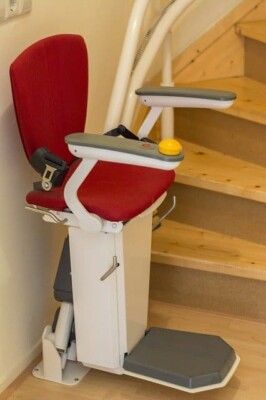Barrier-free living with a stair lift
Home and apartment without obstacles: Young and old benefit from this! After an accident or as a result of a serious illness, spouses and partners of elderly persons or their children are suddenly faced with the decision: move to a retirement home or assisted living or take them home?
Age and illness-related physical limitations in connection with physical movement can at some point make living alone in one’s own home impossible.
If there is still room in one’s own home or if the original home offers the possibility, accessibility is the order of the day. The following explains which measures are necessary and how a barrier-free conversion can also be financed.
Maintaining accessibility and independence in old age
City apartment, fifth floor, no elevator or home over two floors, also no elevator: for decades, this has been the home of suddenly physically impaired relatives.
As a result of an illness, it suddenly turns out: Back to the familiar environment – that is often no longer possible for people with physical limitations.
Walking is difficult, stairs have become insurmountable obstacles, the household can only be managed with a lot of effort, a care degree has been granted. What to do?
This example illustrates what many seniors and concerned family members experience on a daily basis. One day the day has come when those affected can no longer remain living alone in their familiar surroundings.
For some, moving into a retirement home or assisted living is an alternative solution. Others move in with their children or grandchildren.
Homeowners have a great advantage here: enough space, generously cut rooms and the garden as a mental oasis of well-being. In these cases the barrier-free conversion is worthwhile.
Barrier-free conversion with stair lift
If round-the-clock care is not necessary, multigenerational living under the same roof or remaining in one’s own four walls offers a good solution.
But due to suddenly acquired physical limitations, moving in or coming back to one’s own four walls is often not so easy. In most cases, the future home must first be converted to be barrier-free.
Means obstacles, such as steps and barriers, must be removed or bypassed through structural measures. The fact is: despite numerous modernization measures or modern construction methods, single-family homes are often not designed to meet the needs of seniors.
Points of contact for barrier-free living in one’s own home or apartment are housing consultants, local care consultancies and social welfare associations. Small structural adjustments and technical aids such as stair lifts make everyday life easier. Maintain independence and promote overall well-being.
Not being permanently dependent on the help of others is a great good for seniors. If the stair lift is used, the costs for the conversion measures can be effectively reduced.
Convert home and apartment for barrier-free living
Age appropriate modifications should ideally be made when they are not yet needed. The extent of age-appropriate adaptations depends on the specific needs and, of course, on the available budget.
For example, some of the most important measures include:
- Ramp for barrier-free entrance to the house or apartment,
- Stair lift on the stairs to the upper floor,
- Automatically opening front door,
- Non-slip floor coverings,
- Wider, threshold-free access,
- Grab rails or. Handrails.
A stair lift provides accessibility and brings back quality of life
Stairs are often the biggest barrier for those with physical limitations. The installation of a stair lift is the optimal solution in this case. The electrically driven aid transports affected persons safely on a rail system to the upper floor of the house.
Seniors and people with movement restrictions retain their independence, which promotes self-confidence. Stairlifts can always be individually adapted to the needs of their users and the structural conditions on site.
The seat lift variant is often in demand. This type of elevator is ideal for people who can no longer walk well, but are not yet dependent on a wheelchair.
Who promotes barrier-free living with stair lift?
The measures of a barrier-free conversion should always be well planned. Affected persons and relatives should inform themselves about possible subsidies at an early stage. Third parties may contribute to the conversion costs for a stair lift if necessary.
However, the application for financial support must be approved before the modification is made. Health insurance companies support from care degree 1 in the context of „measures to improve the living environment“ with a conversion subsidy of up to 4.000 Euro per person.
